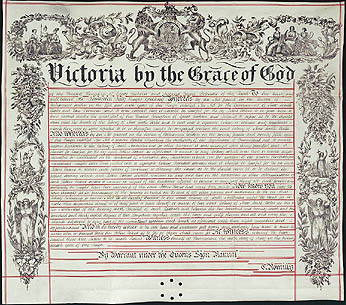

Letters Patent annexing the Northern Territory to South Australia, 1863
Significance
This document established a nameless part of New South Wales as the Northern Territory of South Australia. The land from the western border of Queensland (138 degrees east longitude to the eastern border of Western Australia (129 degrees east longitude) was thus given a name, and placed under South Australian administration. These original Letters Patent sent to the Governor of South Australia in 1863 defined and named the area, laid the legal basis for government and ensured that its citizens had the same rights to political representation as 'old' South Australians.
History
In 1787 Governor Arthur Phillip's Commission established as his domain all land from the east coast charted by Lieutenant James Cook to 135 degrees east longitude (covering the eastern one-third of the future Northern Territory). In 1824, during Governor Brisbane's term of office, the British Government decided to set up a military and trading post on the north coast of Australia. Fort Dundas, on Melville Island, was some 5 degrees west of the defined boundaries of New South Wales, so the Colonial Office included in the Commission issued to the next Governor of New South Wales, Ralph Darling, an extension of the western boundary of New South Wales to 129 degrees east longitude.In 1829 this became the permanent boundary of the new Colony of Western Australia. The three British military/trading posts set up on the north coast (Fort Dundas, 1824–1829); Fort Wellington, Raffles Bay, 1827–1829; and Victoria, Port Essington, 1838–1849) marked Britain's claim to the whole of the Australian continent. In practice each was mainly concerned with British commercial and strategic interests in the Indian Ocean. They failed as trading posts and by the 1840s it was clear that no other country would challenge Britain's claim to the whole of Australia.
In 1846 the British Government produced Letters Patent formally creating a colony of 'North Australia' including the present Northern Territory; but this was revoked in December 1846 and all plans for settlement abandoned.
The boundaries of the future Northern Territory were the result of fixing the northern boundary of South Australia in 1836 and the western boundary of Queensland in 1859 and 1862. Nominally, the 'left-over' area remained part of New South Wales, though after 1862 no part of it touched the border of that Colony. In that year, on the sixth attempt over four years, John McDouall Stuart crossed the continent from Adelaide to the Arafura Sea. He travelled through the entire length of the Northern Territory and earned a £2000 reward offered by the South Australian government. The South Australian government used the work of explorers such as Stuart to justify a claim to include the area within the boundaries of their Province.
South Australia had a European population of 140 000 and half the existing area of the Colony was still unexplored. The Duke of Newcastle, at the Colonial Office, had well-founded doubts about the ability of the South Australian colonists to develop such a vast northern extension, but no other Colony sought responsibility for the 'left-over' area. South Australia's persistence wore down the resistance of a British government believing any development to be better than none, so long as it cost the home country nothing.
On 6 July 1863 these Letters Patent, revocable at Britain's will, were issued, annexing the Northern Territory to South Australia.
This document was the legal basis for South Australian occupation and ensured people in the Northern Territory had the same rights to legal representation as other South Australians. These rights were given effect from 1882; Territorians gained the vote when the Northern Territory was added to the South Australian electorate of Flinders. From 1888 they possessed two members of their own in the South Australian Legislative Assembly and voting rights for the Legislative Council. The few white women in the Northern Territory shared the franchise with their South Australian sisters when that Colony became the first to grant full voting rights to women in 1894. South Australia automatically included all white adult Territorians in Commonwealth electorates after Federation.
Sources
Heatley, Alistair and Nicholson, Graham, Selected Constitutional Documents on the Northern Territory, Northern Territory Department of Law, Darwin, 1989.
Powell, Alan, John Stokes and the Men of the Beagle: Discoverers of Port Darwin, Library Services of the Northern Territory, Darwin, 1989.
Powell, Alan, Far Country: A Short History of the Northern Territory, Melbourne University Press, Melbourne, 1996.
Description
| Long Title: | Letters Patent annexing the Northern Territory to South Australia 1863 |
| No. of pages: | 1 |
| Medium: | Vellum |
| Measurements: | 55 x 20 cm |
| Provenance: | British Government |
| Features: | Decorative illumination on borders |
| Location & Copyright: | State Records of South Australia |
| Reference: | SRSA: GRG 224/131 |
